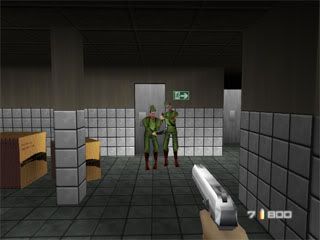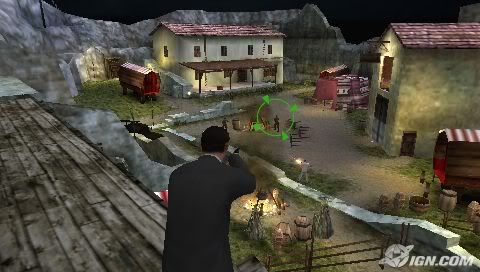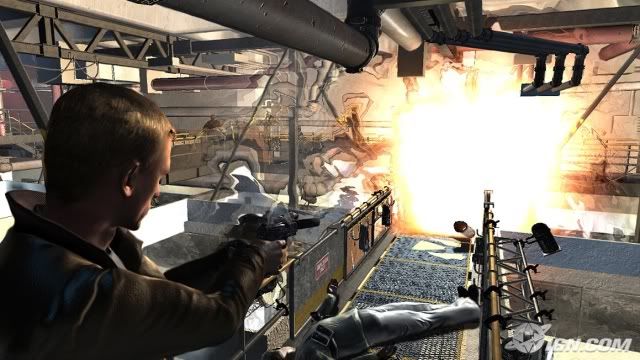Playing the game this morning (the facility level) I began to apply to Goldeneye 007 some ideas that I have previously explored. As you may or may not know, I have an escalating interest in the application of cinema (and in extension, video games) to various conceptions of “real life experience” a la Andre Bazin’s “Myth of Total Cinema”. In short, I’m close to comfortable stating that I don’t think Total Cinema (cinema as an attempt at an all-encompassing recreation of reality) is a myth at all. Without getting too divergent on this topic, I’d like to skip ahead a little.
The first person shooter genre is in my eyes a very important step on the path to Total Cinema. As the name implies, in the FPS the player is the “first person” to experience what the in-game character experiences. Alternatively, second-person implies a player address, like in text- based adventures (“You find yourself at a fork in the road. Do you turn right, or left?”), while the third-person perspective suggests the player as an omniscient controller of a visibly “other” character.
 First-Person
First-Person Second-Person
Second-Person Third-Person
Third-PersonImplicitly, the first-person perspective places the player within the in-game character. As I mentioned in my colloquium presentation on video-game sound experimentation, the first-person shooter allows the player a subjective experience parallel to the in-game character. If one wishes, they may refer to Bordwell and Thompson’s "Film Art" and their discussion on Perceptual and Mental Subjectivity in traditional cinema. Perceptual subjectivity is simple; the film gives “access to what characters see and hear”. A good example of this is the Point of View shot – the shot that first-person shooter permanently assumes. While in cinema, mental subjectivity is the use of stylistic devices to provide insight to what characters think, FPS’ often simply provide perceptual subjectivity to allow players to assume their own desired mental state. Obviously this is not always the case. In Goldeneye 007 for example, coloured bars appear at the sides of the screen upon character injury (a possible visual cue for “panic”). Similarly, N64’s Perfect Dark applies a trippy, blurred slo-mo effect when Joanna Dark gets punched or sedated.
In my colloquium presentation, I focused mostly on sonic subjectivity in the FPS. Using Call of Duty 3, I indicated to several examples where in-game sound is presented to the player using surround sound technology, subjective to the character's own experience. Environmental and diegetic sounds are heard in subjectivity to the direction that the character is facing, in effect to the acoustics and conditions of the setting. The best example I can present is the “ringing ears” effect, when all sounds are deafened by a constant ringing when a grenade explodes near the character.
While I may seem enthusiastic about the FPS’ subjectivity, there are some problems that I considered while playing Goldeneye 007 this morning. There are many limitations that have yet to be overcome by the FPS’ genre. Most of these limitations are based on player perspective. While it is interesting to consider the physical relationship that the player has with the character (the player physically exerts energy and muscle to push controller buttons in order to “physically” move the in-game character through virtual space) this process is still very crude. Here is a list of limitations that I immediately notice:
- The in-game character lacks peripheral vision. This may extend to the wide-screen cinema which arguably imitates a person’s field of vision. I noticed this as I was swiftly moving around a corner in The Facility, and was unable to quickly check a blind-spot for enemies (much like checking a blind-spot while driving)
- A player’s eyes are indefinitely disconnected from the character’s. Instead of forcing a relationship between gamers’ eyes and character eyes, the game creates a contract between gamer and game which encourages the gamer to assume and inspect the character’s presented field of vision. This problem introduces many other problems such as the quality of the gamers’ eyes, the difference between player depth of field and character’s depth of field etc.
- While recent developments in dual-analogue controls have rendered the character’s legs independent of the character’s waist (players can now move in one direction but pivot/point in a separate direction), independence of the character’s neck has yet to be brought into mainstream consideration. The character’s eyes are inherently connected to the direction that he/she is pointing their weapon. I have seen variations of temporary solutions to this, most of which assume a temporary third-person perspective. This unfortunately removes a level of subjectivity from the mix. I have also seen flight simulators which detach the eyes from the weapon, allowing the player to look from side-to-side within the cockpit.

While normally a first-person shooter, Quantum of Solace also uses a third-person cover system in order to detach the character's eyes from his gun
If anyone can think of other problems with the first-person perspective, or examples that overcome some of these problems, please let me know.
